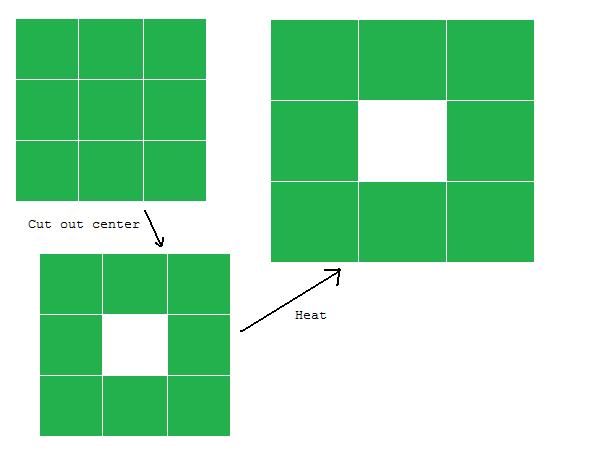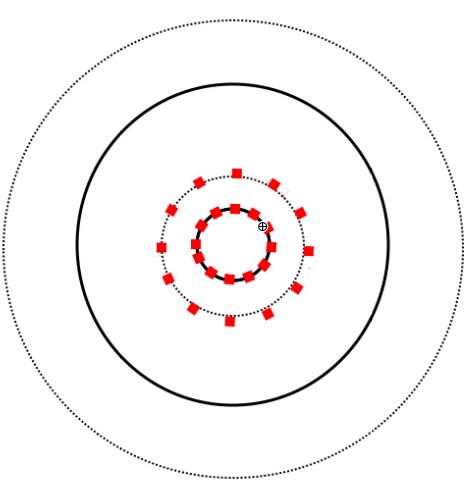Take a metal disc and cut a small, circular hole in the center. When you heat the whole thing, will the hole's diameter increase or decrease? and why? What will happen to the diameter of disc?
-
3$\begingroup$ i have a doubt.Consider the particles on the outer circumference of the disc expand outwards..and the inner circumference expand inwards....so the volume is increasing with the mass remaining constant...so with the explanation in one of the above answers it is possible that the hole's diameter decreases as the density is decreasing(in one of the answers it was mentioned that as density increases it is not possible)..but it does not happen.why? $\endgroup$– user8673Commented Apr 14, 2012 at 9:02
-
3$\begingroup$ Here is a way to think about it that makes the answer obvious. Replace 'cut a hole into with 'draw a circle on' and consider what happens to the drawn circle when the disc is heated. $\endgroup$– SnowhareCommented Apr 14, 2012 at 13:51
-
3$\begingroup$ @BenjaminFranz That does not make the answer obvious (at least to me). It presumes that the "cut a hole into" and "draw a circle on" scenarios are equivalent, but that's begging the question. Why are they equivalent? $\endgroup$– jamesdlinCommented May 2, 2013 at 2:39
-
$\begingroup$ The first comment gives a really cool way of thinking about it. It is a great argument. I'm stealing it. My thought process was a tad less convincing. $\endgroup$– VendettaCommented Oct 24, 2017 at 18:15
8 Answers
Instead of a circular hole, let's think of a square hole. You can get a square hole two ways, you can cut it out of a complete sheet, or you can get one by cutting a sheet into 9 little squares and throwing away the center one. Since the 8 outer squares all get bigger when heat it, the inner square (the hole) also has to get bigger:

Same thing happens with a round hole.
This is confusing to people because the primary experience they have with stuff getting larger when heated is by cooking. If you leave a hole in the middle of a cookie and cook it, yes, the cookie gets bigger and the hole gets smaller. But the reason for this is that the cookie isn't so solid. It's more like a liquid, it's deforming. And as Ilmari Karonen points out, the cookie sheet isn't expanding much so there are frictional forces at work.
-
2
-
7$\begingroup$ The reason why cookies don't expand uniformly when baked has probably more to do with the fact that they're in semi-adhesive contact with the baking tray, which is both much stiffer than cookie dough and expands much less during the process, and which thus provides an external force counteracting the dough's expansion and deforming it. I suspect that, if you were to bake a cookie with a hole in free-fall, suspended in air without a tray, the hole would expand. $\endgroup$ Commented Jul 24, 2012 at 19:58
-
1$\begingroup$ (In fact, it occurs to me that, in the absence of a convenient free-fall cookie oven, one might be able to conduct an equivalent experiment by (slowly) deep-frying the annular cookie instead. Hmm... it might be time for some science, here.) $\endgroup$ Commented Jul 24, 2012 at 20:03
-
4$\begingroup$ Nice comment, however, I've seen doughnuts where the hole closes up due to frying. $\endgroup$ Commented Jul 25, 2012 at 18:08
-
$\begingroup$ Same explanation that my teacher used! :D $\endgroup$ Commented Jan 8, 2017 at 6:49
David Zaslavski's answer is correct and complete. But I want to propose a different way to look at the problem.
Think of the disc that was cut out, and imagine that you heat it too, exactly as you heat the plate. After heating, the disc will fit in exactly to the hole, just as if it was first heated and then cut out. Therefore, the hole will expand.
-
11$\begingroup$ I feel like this answer is begging the question. Why must the whole disc expand in the same way whether or not a smaller disc was cut out of its center? How do you know that the cut-out disc will fit exactly into the hole? For example, I could argue that without the expanding center piece, there is nothing providing an outward force to make the hole bigger. $\endgroup$ Commented May 2, 2013 at 2:32
-
2$\begingroup$ @jamesdlin I agree that it's heuristic and as such one could argue differently. The real solution is sketched by David Z. If you want more justification, you can say that the thermo-elastic equations with $T=const$ and stress-free BC will result in a stress free configuration (easily verified). Therefore, having the disc in place or cut out has no effect on the surrounding - the "interaction" is the stress, and therefore stress free boundary conditions are equivalent to not having a disc at all. Again, I stress that this can be solved analytically and then there's no ambiguity. $\endgroup$– yohBSCommented May 2, 2013 at 6:50
Good question! Assuming the disc is uniform and isotropic (the same in different directions), the hole will expand in the same ratio as the metal. You can see this because the thermal expansion equation
$$\mathrm{d} L = L\alpha\mathrm{d}T$$
applies to all lengths associated with the metal, including the circumference of the hole, since the edge of the hole is made out of metal. And if the circumference of the hole expands, so does the diameter.
If you have a disc with different regions that are made of different types of metal, or if the metal that makes up your disc has an anisotropic crystal structure (so that it expands by different factors in different directions), then the analysis is more complicated. But in both cases, I think the hole would still get larger since the overall change in size is still an expansion.
In order to get the hole to shrink, you would need to use a material with a negative thermal expansion coefficient $\alpha < 0$, which means it gets smaller as the temperature gets higher. In that case the entire disc would shrink as it heats up. Wikipedia has an entry on these kinds of materials (h/t Kevin Reid).
-
2$\begingroup$ Wikipedia on materials with negative thermal expansion. $\endgroup$ Commented Jul 22, 2011 at 13:51
-
2$\begingroup$ Consider the disc made of isotropic material is heated uniformly across its area... the metal near the outer circumference, tries to expand outward because of resistance from its disk-side neighboring molecules. Similarly, the part that is near the inner circumference of the hole (cut-out part) tend to expand to its free side, and thereby covering up the hole $\endgroup$– MallikCommented Mar 15, 2012 at 17:50
-
2$\begingroup$ @Mallik: But it would also try to expand along the ring, and if it moves inward, it has even less space. Therefore it has to move outwards in order to expand (with the outer parts moving outwards more). $\endgroup$– celtschkCommented Apr 15, 2012 at 21:54
-
1$\begingroup$ So lets make it shor and sweet...all of the molecules in a heated disc must now be vibrating more and therefore they occupy more space. That is true for all the molecules and even for ones that are on the edge of the hole in the middle. So if hole gets smaller molecules get closer...and this is not possible...SO the hole has to get bigger. $\endgroup$ Commented Aug 3, 2017 at 15:37
If you worked in an auto shop, you'd know the answer already.
When an axle gets stuck in a ball bearing, one way to pull it out is to heat up the bearing with a welding torch. The whole bearing, including the hole in the middle, expands and allows you to pull the axle free.
-
9$\begingroup$ ... and you have to be careful to heat the bearing more than you heat the axle. $\endgroup$ Commented Dec 17, 2011 at 16:27
-
6$\begingroup$ Or even if you were a medieval blacksmith fitting a metal rim on a wheel. $\endgroup$ Commented Sep 23, 2012 at 4:35
Im a machinist. We commonly heat holes to expand them in various applications. For example, to install bearings that demand a press fit. We use liquid nitrogen to also freeze the bearings. When both objects return to ambient temps the results are that the hole shrinks. We can even control within some tolerance how much. Consider on an atomic level what is taking place. At the end of day? Heat a hole, and it expands. When it cools it will shrink.
I think that there is an important assumption at work here. The hole will expand as long as the material is sufficiently rigid; since most things that we want to expand are rigid (jar lids and axle bearings, for example), and since a disk is likely to be made from a comparatively rigid alloy such as steel, it is generally fair to say that the hole would expand. But I think that you could also create a disk in which the hole would shrink; I would expect a hole in a disk made from a malleable material with a high thermal expansion coefficient (such as gold or lead) to shrink.
-
2$\begingroup$ This is analogous to the reason that the holes in cookies get smaller, not larger, when baked. $\endgroup$ Commented Oct 2, 2012 at 12:04
I know it has been answered already. Just a different perspective.
When a solid body is heated, it expands as if we look though a magnifying glass - everything looks bigger, including the hole in the disc.
Hence the hole in the expands when it is heated up.
-
2$\begingroup$ This is just an assertion and it's basically begging the question. Your claiming, with no justification, that the system is identical to some other system, and then claiming that they have the same behaviour. Why should anybody believe your answer, rather than the following (incorrect) claim? When a solid body is heated, it expands as if it's a cake baking and, when donuts cook, the hole in the middle gets smaller. Hence, the hole contracts when it is heated up. Both claims are just "heating metal is like this other thing, so the hole behaves the same way as that." $\endgroup$ Commented Jun 16, 2019 at 12:31
-
$\begingroup$ @DavidRicherby The current top answer by Carl Brannen uses the same logic of expansion with no deformation without even mentioning that it does that. Here we have a useful analogy for the way such expansion behaves. $\endgroup$– hkBstCommented Nov 15, 2020 at 9:29
I would like to add a microscopic perspective to this question that were mentioned in comments but which I think deserves more attention. A macroscopic body expands when heated because the average separation between molecules increases.
The picture below shows a disc with a hole. The external and internal radius are showed by solid lines. The red dots along the internal circle represent the molecules in that circle. When we heat the disc the average separation between molecules must increase and of course this happens to molecules in the internal circle as well. Since the numbers of molecules in the internal circle cannot change for a solid, the internal circumference becomes bigger after thermal expansion (dotted lines).

